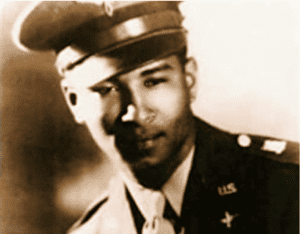 Victor W. Terrelonge
Victor W. Terrelonge
1923 – 2011
Victor Terrelonge was born in St Andrew, but grew up in Morant Bay, at his grandparents’ home. He migrated to the United States (US) in 1937, attended Aviation High School in New York City, and later enrolled at City College of New York to pursue an aeronautical engineering degree. He interrupted his studies after Pearl Harbor was bombed. He wanted to serve, but where? Not in the infantry as films and stories of World War I indelibly etched scenes of trench warfare in his mind. The navy was appealing until he learned that blacks were consigned to either cleaning or cooking. There was no air force at the time, but he was taken by the idea of flying from newsreel films. He went to the Naval Recruiting Center where he was given an exam, which he passed, but was misled on the results. The room was told that if your name wasn’t called, you had failed and you had to leave. Terrelonge was never called, but he remained riveted to his seat. When asked why he was still sitting, he respectfully demanded to see his score. He was correct. He had passed. There was a problem. He could enlist to do the menial things the armed services reserved for blacks, but not become a pilot in the navy in 1940s US. Young Victor just wanted to serve and would not be put off so easily. His determination to learn his score caused the recruiter to act.
Becoming a Tuskegee Airman wasn’t easy. Victor had to complete more tests to even enter the program. Those were not his only obstacles, however. Being a small-bodied teenager, he was underweight. Again, fate stepped in. “I was told to go to the water fountain and drink some water. I took a few sips and started walking back. The doctor told me to go back and drink until he told me to stop. I drank until I couldn’t anymore,” he said. “He called me back to the scale and I made it.” The next step was to get his mother’s signature on the permission slip to allow him induction, as he was underage. His mother, Florence McQueen Terrelonge-Stewart (the first black employed as a nurse at Harlem Hospital), didn’t like the idea of her son flying. “If God had wanted you to fly, you would have been born with wings,” she told him. Days went by. A restless Victor got another break. His big sister Olive, knowing his desire, asked him if he still had the permission letter. “Yes.” “Bring it to me.” She signed their mother’s name and Victor was off to the recruiter.
He did not advance beyond cadet training and did not fly missions over Europe. Because Terrelonge did train with the racially segregated cadet corps during WWII, he is properly considered a member of the Tuskegee Airmen. Members of the group were collectively awarded a bronze replica of the Congressional Gold Medal – the nation’s highest civilian honor on March 29, 2007 from former President George W. Bush and the Congress. Those present at the one -time only ceremony represented the estimated 16-19,000 participants of the “Tuskegee Experience” (1941-1949).
Following the ceremony, the original CGM was taken to the Smithsonian Institution, Air and Space Museum. It was later transferred to the National African-American Museum, where it currently sits.
Sources:





